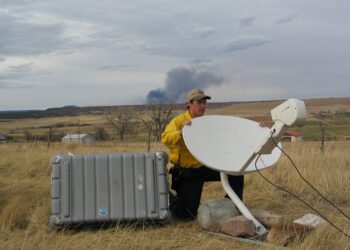By Micah Drew DAILY MONTANAN
The federal government on Wednesday proposed rescinding a Bureau of Land Management rule that allows the department to consider conservation as part of its multi-pronged approach to federal land management.
The change comes as the Trump administration continues pushing for increased resource utilization of public lands, including through logging and mining.
The proposal drew immediate reactions from Montanans — with political leaders praising the reversal as helpful to energy production but conservation groups decrying it as another harm to public lands access.
“President Trump and Secretary Burgum are bringing back commonsense land management policies that will benefit Montana farmers, ranchers, and producers,” Montana U.S. Sen Steve Daines said. “The harmful Public Lands Rule would have blocked access to use of public lands for outdoor recreation and also would have restricted energy production, grazing, and forest management. By rescinding the Public Lands Rule and unlocking more timber sales in Montana, we’ll be better able to manage our forests and prevent catastrophic wildfires. President Trump is committed to Treasure State priorities and this is welcome news.”
Interior Secretary Doug Burgum said in a department press release that the “Public Lands Rule” exceeded BLM’s authority and placed an “outsized priority” on conservation use of federal land, threatening energy development, grazing and recreation use.
“The previous administration’s Public Lands Rule had the potential to block access to hundreds of thousands of acres of multiple-use land – preventing energy and mineral production, timber management, grazing and recreation across the West,” Burgum said. “The most effective caretakers of our federal lands are those whose livelihoods rely on its well-being. Overturning this rule protects our American way of life and gives our communities a voice in the land that they depend on.”
The Biden-era rule, formally the Conservation and Landscape Health Rule, went into effect in spring of 2024, as a way to better define how the BLM approaches land management decisions. According to the final decision in the federal register, the rule helped clarify the Federal Land Policy and Management Act of 1976, by letting the department protect “intact, functioning landscapes;” offer restoration and mitigation leases, alongside grazing and extraction leases, to restore degraded habitats and ecosystems; and emphasize landscape health in decision making by utilizing science and data, including Indigenous Knowledge.
“The rule does not prioritize conservation above other multiple uses. It also does not preclude other uses where conservation use is occurring. Many uses are compatible with different types of conservation use, such as sustainable recreation, grazing, and habitat management. The rule also does not enable conservation use to occur in places where an existing, authorized, and incompatible use is occurring,” the final rule states.
The rule drew the ire of industry groups and politicians across the west, including Burgum, then-Gov. of North Dakota, and Montana Gov. Greg Gianforte, who along with the state of Idaho sued the federal government over the conservation rule. The BLM manages more than 8.3 million acres of federal land across Montana and the two Dakotas.
Conservation and recreation organizations, along with an overwhelming majority of the public that weighed in on the rule, supported allowing conservation and restoration to be considered more actively by federal land management agencies. According to an analysis by the Center for Western Priorities, 92% of more than 150,000 public comments supported the rule.
Outdoor-oriented policy and advocacy groups, including the Sierra Club, The Wilderness Society and the National Parks Conservation Association released statements opposing the change en masse on Wednesday.
“Every one of this administration’s public-lands policies is designed to sell out public access, recreation, clean water, and wildlife to boost corporate profits. ‘Multiple-use’ doesn’t mean that oil and gas corporations get to dictate what happens to our public lands,” said Aubrey Bertraim, federal policy director of Wild Montana. “Rolling back the Public Lands Rule is another way to cut out public input, undermine local management, and give industry and billionaires control of the places where we hike, hunt, fish, camp, and ride. Who cares if that hurts regular Montanans? It’s time to call this what it is: The latest move in a systematic approach to dismantle the public lands that support our way of life.”
The Outdoor Industry Association in a press release said the change would hurt economies and businesses that rely heavily on the outdoor recreation industry.
“America’s public lands are the engine of the $1.2 trillion outdoor economy and should be protected so future generations can continue hiking, climbing, and recreating in our most cherished places,” Outdoor Industry Association president Kent Ebersole said. “The rescission of the public lands rule would not only prevent accessible outdoor recreation on these vital lands but also hurt the small businesses and gateway communities that rely on it. The outdoor industry urges the administration to reconsider this decision and protect the landscapes that are vital to local economies, small businesses, and the outdoor recreation community.”
Many opponents of the Public Lands Rule claim it excluded grazing, extraction and recreation in favor of conservation, but the rule specifically states that it “does not prioritize conservation” above other uses, but puts them on equal footing in decision making. The text of the rule describes how conservation is an essential piece of the planning and management process. As an example, the rule states that a restoration lease could be paired with a grazing lease to allow tracts of public land to recover between periods of grazing.
But the Interior Department said rolling back the rule will also offer a more stable future for extraction and energy industry stakeholders concerned about litigation or permitting delays that could be brought forth under the rule.
“The rescission of the Public Lands Rule will eliminate unnecessary barriers to energy development and support the multiple-use mandate of the BLM by not prioritizing conservation over all other uses,” according to the Interior Department.
Rich Nolan, President and CEO of the National Mining Association, praised the move, saying the Biden had “unlawfully placed conservation above all else.
“This new rule reinstates the balance of federal land use intended by Congress, ensuring that our vast resources can meet today’s soaring energy needs and become the secure mineral supply chains for American industry,” Nolan said in a statement.
According to the BLM website, the policy on restoration and mitigation leasing has already been declared inactive as of Feb 27 of this year, following one of Trump’s executive orders from early in his term.
The Federal Register notice published on Wednesday, kicking off a 60-day comment period on the proposed rule rescission.
A screenshot of the BLM’s website on Sept. 11, 2025.














